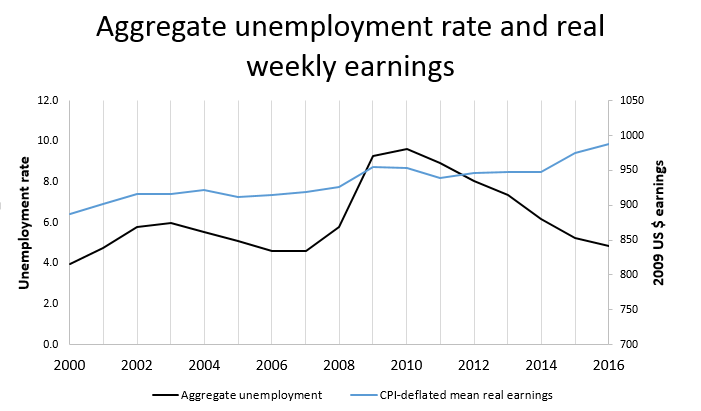OPINION PIECE: Not bad at all—the true state of the US labor market

An important seat in President Trump’s cabinet remains unfilled: The seat of the labor secretary. If Alexander Acosta is confirmed in this position according to Trump he “is going to be a key part of achieving our goal of revitalizing the American economy, manufacturing and labor force.” But does the American economy need revitalizing? In a new IZA World of Labor opinion piece US economist Dan Hamermesh looks at the true state of the US labor market and comes to the conclusion: Not bad at all.
Not bad at all—the true state of the US labor market – by Daniel S. Hamermesh
In his February 25 New York Times opinion piece “A time for immodest proposals” Ross Douthat quoted a right-leaning economist who stated that the US labor market is not doing well, with unemployment high and wages stagnating. This seems to be a general opinion, with Donald Trump complaining during the election campaign about high unemployment and Bernie Sanders arguing about falling living standards. With a carefully chosen base period for comparison, one can easily demonstrate either improving or declining conditions; but the correct basis is a time when unemployment is about the same as today’s 4.8%. As the figure shows, that time is 2000.
By historical standards today’s unemployment rate indicates we are about at full employment, and it is little different from 2000. Moreover, the post-inflation (real) earnings of the average worker (even using the usual, overstated measure of price inflation, the Consumer Price Index) have risen since 2000 at an average annual rate of about 0.6% per year. This growth is below what it was from 1945-1970, but not bad by historical standards.
So why all the complaining and malaise? First, politicians don’t defeat others by gloating how well things are going. Bemoaning the state of the economy paid off in 2016. Second, while the unemployment rate is low, about six million people are not seeking work as compared to what would have been expected in 2000. That’s their free choice—if people want to work less, who are we to object; but the American puritanical ethic may object to their choice? Finally, wage inequality continues to rise, with most rapid growth among the very highest earners. Perhaps the biggest problem in the US labor market is that most people do realize that their wages are growing, although fairly slowly, but see a very visible few getting further and further ahead of them.
This opinion piece is based on an in depth report by Professor Hamermesh on the labor market in the United States, 2000-2016, due to be published on IZA World of Labor in May. Please get in touch should you wish to read the report in advance of publication.
Media Contact:
Please contact Anna von Hahn for more information or for author interviews: anna.vonhahn@bloomsbury.com or +44 7852 882 770
Notes for editors:
IZA World of Labor (http://wol.iza.org) is a global, freely available online resource that provides policy makers, academics, journalists, and researchers, with clear, concise and evidence-based knowledge on labor economics issues worldwide.
The site offers relevant and succinct information on topics including diversity, migration, minimum wage, youth unemployment, employment protection, development, education, gender balance, labor mobility and flexibility among others.
Established in 1998, the Institute of Labor Economics (www.iza.org) is an independent economic research institute focused on the analysis of global labour markets. Based in Bonn, it operates an international network of about 1,300 economists and researchers spanning more than 45 countries.